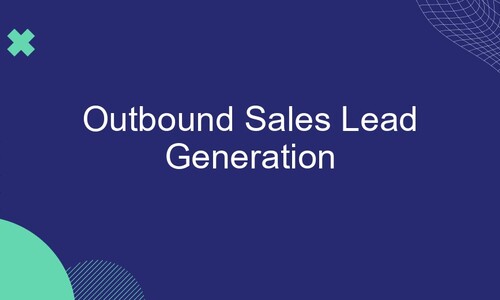Revolutionizing Lead Generation: Simplifying Outbound Sales
 By
By
Success in an increasingly saturated sales environment relies on speed and precision. As outbound sales teams need to determine who their target is, they're also in a time crunch when it comes to lead generation generating leads that take away from personal client engagement and timely follow-up efforts. However, with the competition always right around the corner, sales is a startup venture every micro company and mom-and-pop shop can benefit from an advantage but with the latest advancements in technology, they'll be able to create higher quality leads and follow up and close sales faster than ever before. It's automation and precision targeting that facilitate outbound sales efforts nowadays and save time. For instance, Anybiz.io is but one of many such services that streamline the search for leads potential client companies could be ignoring when they should be focused on more advantageous customer service efforts. Automation impacts how companies generate leads. Instead of a manual and labor-intensive process that expands a lot of time and effort on a fruitful campaign, it's a generated process that expends less time and effort on an efficient campaign. Where sales teams had to painstakingly ensure every detail of prospecting, now they can save that time and effort for closing and relationship building. However, at the same time, these efforts are ensured. No one falls through the cracks. Automated targeting of prospects, automated first outreach via a generated welcome email, and automated subsequent outreach to schedule a meeting ensure that all prospects get the same consistent, professional outreach. Maybe the biggest advantage of automation is the ability to scale without actually scaling. This is crucial for small businesses and emerging startups. No longer does it take an extensive amount of time and manpower to compete with larger firms. Now, larger firms can find themselves on the same playing field as smaller firms and vice versa as long as they have access to proper automated tools that allow them to sift through quality leads, generate personalized outreach, and achieve follow-up objectives without requiring a larger team. Yet automation facilitates more accurate lead generation as well. Automated lead generation relies on data-driven assessments to create and locate likely candidates based on previous engagement, industry, and company size. Rather than a shotgun approach to determine what may or may not work, a sales team now has access to vetted, reliable lists of all candidates from which to generate leads more prone to becoming sales. Furthermore, automated systems update and alter prospect lists so that they stay relevant to the organization's needs over time. Another key benefit is the concept of mass personalization. As mentioned, much of the busy work in conceptualizing an email and pushing it out down the line is reduced thanks to automation. But that doesn't mean the message quality suffers. The software accessible today features dynamic content fields. Thus, the sales department can still send an email that appears tailored to that specific person. Such trust is needed for people to give and take. Ultimately, sales automation lets salespeople sell. It simplifies nurturing leads and fulfilling client needs, all while improving rapport. When people aren't distracted by busy work, they can use their skills in the capacity that works best for them. Furthermore, when it comes to lead generation, it's all the more productive as the automated systems remove the detritus efforts that would otherwise be a waste of time and make everything more productive and successful. For companies eager to grow and sustain viability, the sooner they integrate automated systems into their day-to-day operations, the better the in-house operations and the better the success rate. Modern outbound sales software is replete with functionalities that engage any stage of the sales funnel. For example, one such feature that boasts great success is that of email personalization. When people get personalized emails, it resonates with them humanely for example, sales teams can customize communication to nearly everyone. Personalized emails have higher response rates and greater engagement. The other revolutionary aspect is automated follow-up. Manually needing to follow up with prospects can be a tedious, time-consuming endeavor; yet with automation, follow-up happens timely, with increased frequency as it's programmed to ensure prospects remain engaged. In addition, comprehensive analytics enable a team to review all KPIs from open rate to click rate to engagement and conversion. This information fosters strategic changes and improves the overall success of the campaign. Along with increased transparency, these analytics provide a roadmap for outbound sales efforts that, before, made for a lot of confusion and unclear successful attempts. Knowing what works and what doesn't empowers a sales team to pivot, and any opportunity to pivot is appreciated. For instance, response rates, click rates, and sales conversions all show the team what's successful and what's ineffective, and when everyone is on the same page, time can be better spent in certain areas for more worthwhile efforts. For instance, understanding which subject line gets opened regularly or which CTA is clicked allows the salesperson to formulate a better pitch. So, not only is the interaction customized, but it's also extraordinarily more powerful to do so for goal-achieving purposes. The ability to change a subject line or reword a body or send at a different time, all based on statistical analysis, allows a sales team to improve its endeavors every single time an email is sent and resent for more opportunities of engagement, every single time after that. The sales team is no longer in the dark about the entire process of the sales funnel. Effective engagement tracking software shows who's engaged with which campaign and when. A lead opens an email, goes to a link of a website, and in the end, makes a purchase the sales team knows in real time and can track the process. They also know why and when leads drop off, giving them the ability to fix roadblocks and champion a smoother process. In addition, data allows for successful testing. For example, A/B testing allows a sales team to test and assess anything from the format of an email to the day and time of contact to determine which proves more successful. The findings are priceless for establishing some sort of equation that works now and can easily translate to larger applications later. But data does more than enhance a current, more immediate goal; it adds to the larger, more extensive goal as well. Data helps a company understand what happened in the past and assess what needs to happen in the future with proper projected budgetary factors. For example, data may indicate which verticals or demographics respond best to one product or service right now and paves the way for a more targeted, more effective vertical-focused campaign in the future. Ultimately, making sales optimization an ongoing effort is possible when sustained by a data-driven approach. With the resources literally at their fingertips, sales professionals can more nimbly modify their pitching, enhance conversion rates, and broaden their perspectives efforts that are all easily replicable for subsequent occasions. In today's booming marketplace, data-driven sales isn't just a means to stay ahead of the competition, it's the only way to stay the course. Possibly the greatest benefit of outbound sales is precise targeting. This is not a shotgun approach. Instead, segmentation allows a company to contact those most prone to purchase. Thus, segmenting the contact/lead list by industry, company size, previous outreach, etc., means the potential exists that literally every single message sent is applicable and interesting. For instance, databases like Anybiz.io assist with such access; a sales team can search for potential buyers that equal their buyer persona needs down to the smallest detail. Therefore, reaching out to those already vetted and qualified means that even if they're not in a position to buy at the moment, they've responded to the outreach and appreciated the gesture. This cuts down on time for everyone and increases that person's professionalism. Time is money, and when buyers have already been determined, some direct action down that path increases close ratios and overall sales effectiveness. You know modern selling tools are effective when you read the case studies. More and more companies are expanding their enterprises through automation and analytics. One small startup looking to differentiate itself in a saturated marketplace saw phenomenal growth when it understood the power of engagement automation and targeting accuracy. Twelve weeks later, they saw a 40% increase in authentic engagement, allowing their sales team to close deals instead of playing hide and seek with people interested in what they had to offer. But it wasn't just this one company struggling with follow-up. Another B2B services company had a hard time getting consistent follow-up on his own but post-integration of an automated follow-up system, he was able to double his reply rate and experience a 25% increase in deals closed within 6 months. And these are just two stories of outbound sales success from this one study alone. Outbound sales is becoming a more efficient, effective, and innovative experience. The beauty of it is that as technology continues to play a significant role in society, the potential for improved lead generation and decreased menial tasking with redirected efforts toward more meaningful engagement with prospective clients becomes more and more possible. It isn't just a dream but a reality of companies like Anybiz.io who seek to play this role in the evolution, offering automation, analytics, and targeting features to simplify the outbound sales experience while guaranteeing successful, measurable outcomes. When solutions like these infiltrate the experience, not only will teams benefit from significant time savings, but also better quality of outreach and increased quality of outreach. Whoever has access to these tools and skills will be the salesperson of the twenty-first century. With automation and precision, businesses learn how to scale faster with increased efficiency, secure more sales, and achieve sustainability in the long run.
The Benefits of Automation in Lead Generation
Key Features Driving Success in Outbound Sales
The Role of Data in Sales Optimization
Precision Targeting for Better Results
Real-Life Success Stories
Conclusion




